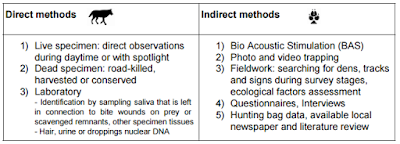Assessment of golden jackal species (Canis aureus, L.1758) records in natural areas out of their known historic range
Technical Report: GOJAGE Criteria and Guidelines
by
Jennifer HATLAUF, Ovidiu C. BANEA, Luca LAPINI
2016 © GOJAGE
Golden jackals show an increasing long-distance dispersal from their known historic geographic range into new areas (Rutkowski et al. 2015). Only in the last years, single golden jackal individuals were reported in Latvia, Lithuania, Poland, Germany or Denmark and a survival cluster of 5 territorial groups (Männil 2016, pers. comm.) is monitored in West Estonia.
The known historic range of the golden jackal species including large parts of Eurasia and Africa was recently reconsidered since the results of new genetic studies suggest that African golden jackals merit recognition as a full species, as they meet the primary defining criterion of a separate and independently evolving metapopulation lineage (Rueness et al. 2011; Gaubert et al. 2012; Koepfli et al. 2015). Accordingly, it was proposed that the common names ‘‘African golden wolf’’ (Canis anthus) and ‘‘Eurasian golden jackal’’ (Canis aureus) be applied to distinguish these taxa, and to distinguish the former from the Ethiopian wolf (Canis simensis). The African golden wolf is distributed across Africa and includes individuals that have been referred to as Canis lupus lupaster or Canis aureus, sensu lato. Morphologic parallelism of African golden wolves and Eurasian golden jackals may have resulted in their mistaken attribution to a single species (Koepfli et al. 2015).
Over the past two decades evidences northward and westward of the known historic range, mostly the Balkan area, were recorded (Kryštufek et al. 1997; Arnold et al. 2011). The native and naturally colonized range of golden jackals in Europe include now Greece, Albania, Montenegro, Republic of Macedonia, Bosnia-Herzegovina, Serbia, Bulgaria, Romania, Hungary, Croatia, Slovenia, Switzerland, Italy, Austria, Slovakia, Czech Republic, Moldova, Ukraine, Turkey, Caucasus countries, Belarus, Estonia, Latvia, Lithuania, Poland, Germany and Denmark. Central and South-East Europe have now a very important role in the golden jackal species conservation since the European or Caucasian golden jackal (Canis aureus moreoticus, I. Geoffroy Saint-Hilaire, 1835) is known as having its main populations in Bulgaria, Greece, Serbia, Croatia, Hungary and Romania.
The main problem in assessing golden jackal proof in new areas is inexperience due to the novelty and rareness of these situations to this point. This report aims to establish common criteria within European countries and abroad for golden jackal species new records that are reported in areas within naturally colonized range.
FULL REPORT HERE
FULL REPORT HERE
Direct and indirect methods used by GOJAGE
GOJAGE CRITERIA
Distinction of golden jackal (Canis aureus, L. 1758) evidences
GOJAGE GUIDELINES












